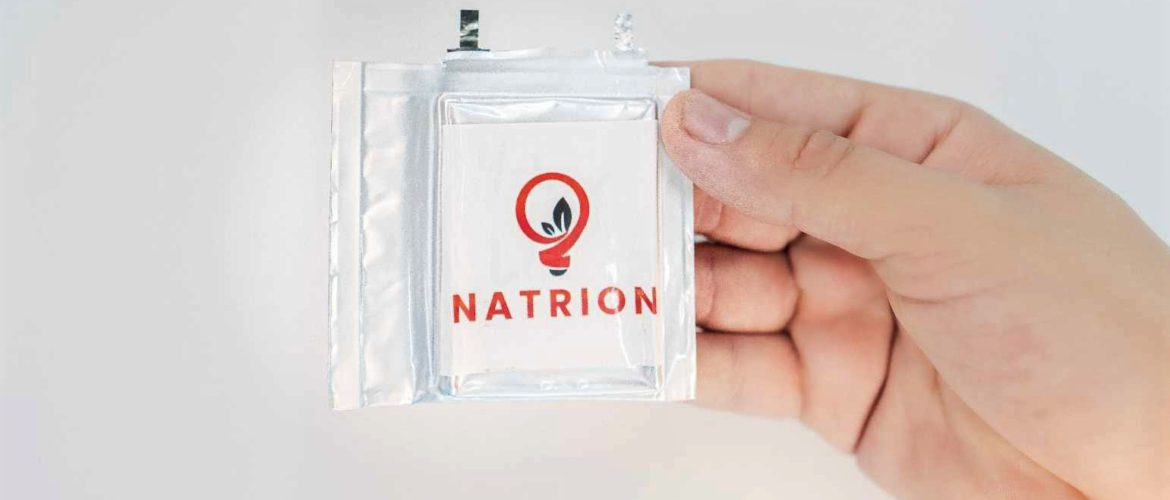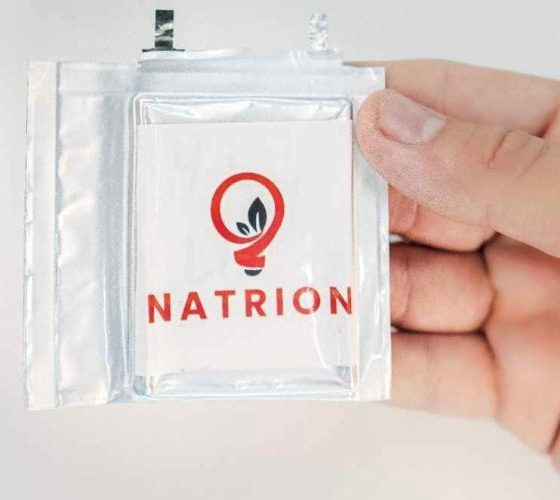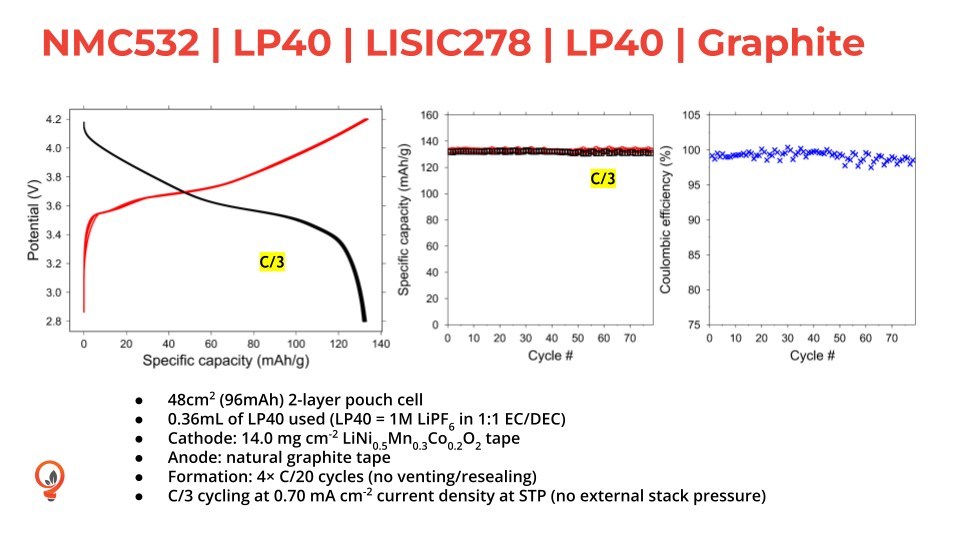

News
Shark Tank-backed Natrion unveils solid-state battery separator with near-zero fire risk
Mark Cuban-backed Natrion has unveiled its latest developments in solid-state battery manufacturing with the new LISIC278 separator in a traditional pouch cell. The separator allows for a higher thermal resistance than other EV batteries, decreasing the risk of fires and combustion. Additionally, the cell showed a 40 percent increase in the charge rate compared to a conventional battery with the same capacity.
Natrion’s LISIC278 material utilizes a Lithium Solid Ionic Composite (LISIC) electrolyte that mimics the performance and specs of a standard polyolefin separator, which sits between the anode and cathode. The purpose of the separator is to prevent short circuits by keeping the electrodes apart while also allowing ionic charges to flow through with the necessary passage of currents in a cell. The LISIC cell can utilize significantly less of the electrolyte liquid by delivering high ion transport capability at ambient conditions. This keeps the cells’ thermal resistance above 200° Celsius (392 F) without having any porosity.
The LISIC278 separator’s ability to remain stable at high temperatures nearly eliminates the risk of fire, while it also exhibits a reduced ability for a thermal event altogether.
CEO and Co-Founder Alex Kosyakov said that reducing flammable liquid electrolytes was a main focus because reducing the perception that battery cells will catch on fire is a key to growing mass EV adoption:
“Reducing our reliance on flammable liquids in EV batteries is key to reducing fire risk and ultimately making mass EV adoption more viable. So the fact that this data shows we can produce battery cells that are just as efficient with only a small fraction of that liquid is a huge win.”

Cycling performance of a two-layer pouch cell at C/3 charge and discharge using LISIC278 with an NMC532 cathode and natural graphite anode.
In addition to the LISIC278 cells’ stability, it also showed a 40 percent increase in charge rate, taking just 3 hours to charge as opposed to 5 hours for a conventional cell with the same capacity. Natrion utilized a standard pouch containing NMC532 cathode, LP40 liquid electrolyte, and a natural graphite anode with a state-of-the-art separator for its experiments. This was compared to the Natrion pouch, which was identical but utilized the LISIC279 separator instead of a conventional design.

The cell with the LISIC279 separator also displayed a high initial coulombic efficiency. Conventional lithium-ion cells “typically” have less energy available than they are charged with when used the first few times. Natrion cells did not display this issue and “exhibited higher initial coulombic efficiencies and resultantly improved capacity retention at higher C-rates,” the company said.
Dr. Jon Tuck, an expert in energy storage for Silent Koala, said using less electrolyte liquid while maintaining a high initial coulombic rate is difficult, especially at the capacity and C-rate threshold given here. “These results are highly promising and show a versatility of use for LISIC that we have yet to see from other solid-state electrolyte materials. It signals the potential of Natrion’s materials to really advance the industry and the technological feats being developed,” Dr. Tuck added.
Natrion is based in Binghamton, New York, and has operations in Champaign, Illinois.
Solid-state batteries utilize a solid material to allow energy to flow from the cathode to the anode, instead of traditional lithium-ion cells, which utilize a liquid electrolyte solution. EV makers have not been able to switch to solid-state technology due to its complex manufacturing processes. Additionally, researchers have not been able to find ideal solutions for the material it would utilize in the batteries, and this continues to be a severe bottleneck of solid-state development.
I’d love to hear from you! If you have any comments, concerns, or questions, please email me at joey@teslarati.com. You can also reach me on Twitter @KlenderJoey, or if you have news tips, you can email us at tips@teslarati.com.

News
Tesla FSD fleet is nearing 7 billion total miles, including 2.5 billion city miles
As can be seen on Tesla’s official FSD webpage, vehicles equipped with the system have now navigated over 6.99 billion miles.

Tesla’s Full Self-Driving (Supervised) fleet is closing in on almost 7 billion total miles driven, as per data posted by the company on its official FSD webpage.
These figures hint at the massive scale of data fueling Tesla’s rapid FSD improvements, which have been quite notable as of late.
FSD mileage milestones
As can be seen on Tesla’s official FSD webpage, vehicles equipped with the system have now navigated over 6.99 billion miles. Tesla owner and avid FSD tester Whole Mars Catalog also shared a screenshot indicating that from the nearly 7 billion miles traveled by the FSD fleet, more than 2.5 billion miles were driven inside cities.
City miles are particularly valuable for complex urban scenarios like unprotected turns, pedestrian interactions, and traffic lights. This is also the difference-maker for FSD, as only complex solutions, such as Waymo’s self-driving taxis, operate similarly on inner-city streets. And even then, incidents such as the San Francisco blackouts have proven challenging for sensor-rich vehicles like Waymos.
Tesla’s data edge
Tesla has a number of advantages in the autonomous vehicle sector, one of which is the size of its fleet and the number of vehicles training FSD on real-world roads. Tesla’s nearly 7 billion FSD miles then allow the company to roll out updates that make its vehicles behave like they are being driven by experienced drivers, even if they are operating on their own.
So notable are Tesla’s improvements to FSD that NVIDIA Director of Robotics Jim Fan, after experiencing FSD v14, noted that the system is the first AI that passes what he described as a “Physical Turing Test.”
“Despite knowing exactly how robot learning works, I still find it magical watching the steering wheel turn by itself. First it feels surreal, next it becomes routine. Then, like the smartphone, taking it away actively hurts. This is how humanity gets rewired and glued to god-like technologies,” Fan wrote in a post on X.
News
Tesla starts showing how FSD will change lives in Europe
Local officials tested the system on narrow country roads and were impressed by FSD’s smooth, human-like driving, with some calling the service a game-changer for everyday life in areas that are far from urban centers.

Tesla has launched Europe’s first public shuttle service using Full Self-Driving (Supervised) in the rural Eifelkreis Bitburg-Prüm region of Germany, demonstrating how the technology can restore independence and mobility for people who struggle with limited transport options.
Local officials tested the system on narrow country roads and were impressed by FSD’s smooth, human-like driving, with some calling the service a game-changer for everyday life in areas that are far from urban centers.
Officials see real impact on rural residents
Arzfeld Mayor Johannes Kuhl and District Administrator Andreas Kruppert personally tested the Tesla shuttle service. This allowed them to see just how well FSD navigated winding lanes and rural roads confidently. Kruppert said, “Autonomous driving sounds like science fiction to many, but we simply see here that it works totally well in rural regions too.” Kuhl, for his part, also noted that FSD “feels like a very experienced driver.”
The pilot complements the area’s “Citizen Bus” program, which provides on-demand rides for elderly residents who can no longer drive themselves. Tesla Europe shared a video of a demonstration of the service, highlighting how FSD gives people their freedom back, even in places where public transport is not as prevalent.
What the Ministry for Economic Affairs and Transport says
Rhineland-Palatinate’s Minister Daniela Schmitt supported the project, praising the collaboration that made this “first of its kind in Europe” possible. As per the ministry, the rural rollout for the service shows FSD’s potential beyond major cities, and it delivers tangible benefits like grocery runs, doctor visits, and social connections for isolated residents.
“Reliable and flexible mobility is especially vital in rural areas. With the launch of a shuttle service using self-driving vehicles (FSD supervised) by Tesla in the Eifelkreis Bitburg-Prüm, an innovative pilot project is now getting underway that complements local community bus services. It is the first project of its kind in Europe.
“The result is a real gain for rural mobility: greater accessibility, more flexibility and tangible benefits for everyday life. A strong signal for innovation, cooperation and future-oriented mobility beyond urban centers,” the ministry wrote in a LinkedIn post.
News
Tesla China quietly posts Robotaxi-related job listing
Tesla China is currently seeking a Low Voltage Electrical Engineer to work on circuit board design for the company’s autonomous vehicles.

Tesla has posted a new job listing in Shanghai explicitly tied to its Robotaxi program, fueling speculation that the company is preparing to launch its dedicated autonomous ride-hailing service in China.
As noted in the listing, Tesla China is currently seeking a Low Voltage Electrical Engineer to work on circuit board design for the company’s autonomous vehicles.
Robotaxi-specific role
The listing, which was shared on social media platform X by industry watcher @tslaming, suggested that Tesla China is looking to fill the role urgently. The job listing itself specifically mentions that the person hired for the role will be working on the Low Voltage Hardware team, which would design the circuit boards that would serve as the nervous system of the Robotaxi.
Key tasks for the role, as indicated in the job listing, include collaboration with PCB layout, firmware, mechanical, program management, and validation teams, among other responsibilities. The role is based in Shanghai.
China Robotaxi launch
China represents a massive potential market for robotaxis, with its dense urban centers and supportive policies in select cities. Tesla has limited permission to roll out FSD in the country, though despite this, its vehicles have been hailed as among the best in the market when it comes to autonomous features. So far, at least, it appears that China supports Tesla’s FSD and Robotaxi rollout.
This was hinted at in November, when Tesla brought the Cybercab to the 8th China International Import Expo (CIIE) in Shanghai, marking the first time that the autonomous two-seater was brought to the Asia-Pacific region. The vehicle, despite not having a release date in China, received a significant amount of interest among the event’s attendees.








